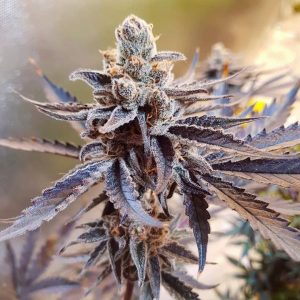Hybrid cannabis refers to a category of cannabis strains that are created by crossbreeding two or more different types of cannabis plants, typically indica and sativa strains. The goal of hybridization is to combine desirable traits from each parent strain, such as specific flavors, aromas, growth characteristics, and effects.
Some common characteristics of hybrid cannabis strains include:
Effects:
When it comes to hybrid cannabis varieties, the effects can vary widely depending on the specific genetic profile and the ratio of indica to sativa traits. Here are some general characteristics and effects commonly associated with hybrid cannabis:
- Balanced Effects: Hybrids are often sought after for their balanced effects, offering a combination of both indica and sativa characteristics. This can result in a more well-rounded experience, providing a mix of relaxation and uplifting sensations.
- Relaxation and Euphoria: Many hybrid strains offer a sense of relaxation and euphoria, helping to alleviate stress and promote a positive mood. These effects can be beneficial for relaxation, socializing, and overall well-being.
- Physical and Mental Effects: The effects of hybrid strains can impact both the body and mind. Depending on the specific strain, you may experience a blend of physical relaxation, mental clarity, creativity, focus, or even a slight increase in energy.
- Pain Relief: Certain hybrid strains are known to provide effective pain relief, making them a popular choice for individuals seeking therapeutic benefits. They may help with managing chronic pain, muscle tension, or inflammation.
- Customized Experiences: Hybrid strains offer a wide range of possibilities, allowing breeders to tailor specific characteristics for different desired effects. Some hybrids may lean more towards indica dominance, providing a more sedating and relaxing experience, while others may lean towards sativa dominance, offering more uplifting and energizing effects.
It’s important to note that individual experiences can vary, as the effects of cannabis are influenced by factors such as dosage, personal tolerance, and unique body chemistry. It is always advisable to start with a low dosage and gradually increase if needed, and to choose cannabis products from reputable sources.
When exploring specific hybrid strains, it’s recommended to consult with a knowledgeable budtender at a licensed dispensary who can provide strain-specific information and recommendations based on your desired effects and preferences.
Aroma and Flavor:
When it comes to the aroma and flavor of hybrid cannabis varieties, they can vary widely depending on the specific genetic profile and the presence of different terpenes. Terpenes are organic compounds found in cannabis that contribute to its scent and taste. Here are some general characteristics of aroma and flavor in hybrid cannabis:
- Diverse Aromas: Hybrid strains can exhibit a wide range of aromatic profiles due to the combination of different terpenes inherited from their parent strains. Some common terpenes found in hybrids include myrcene, limonene, pinene, caryophyllene, and linalool. This can result in diverse aromas such as citrus, earthy, pine, floral, fruity, spicy, or herbal.
- Complex Flavors: Hybrid strains https://gg4.store/ often offer complex and multi-dimensional flavor profiles. The combination of different terpenes and their interactions can create a variety of tastes. It’s not uncommon to find hybrids with flavors that blend sweetness, fruitiness, earthiness, spiciness, and even hints of diesel or skunk, among others.
- Balanced Profiles: Depending on the specific hybrid strain, the aroma and flavor can reflect a balanced blend of its parent strains. This can lead to a harmonious combination of different scents and tastes that can be unique and enjoyable.
- Strain-Specific Characteristics: Each hybrid strain has its own specific aroma and flavor characteristics. Some strains may have a dominant terpene profile that gives them a distinct aroma, while others may exhibit a more diverse range of terpenes, resulting in a complex flavor profile.
It’s important to note that individual experiences and perceptions of aroma and flavor can vary, as they can be influenced by personal preferences and sensory sensitivities. The best way to explore the aroma and flavor characteristics of a specific hybrid strain is to experience it firsthand or consult with a knowledgeable budtender at a licensed dispensary who can provide strain-specific information and recommendations.

Appearance:
The appearance of a hybrid cannabis variety can vary depending on its genetic lineage and cultivation factors. Here are some general characteristics of appearance in hybrid cannabis:
- Bud Structure: Hybrid cannabis strains can exhibit a range of bud structures, which can be influenced by their indica and sativa genetics. Buds may be dense and compact, loosely formed, or somewhere in between. The specific structure can also be influenced by cultivation techniques and environmental conditions.
- Size and Shape: The size and shape of the buds can also vary. Some hybrid strains may produce larger, chunkier buds, while others may have smaller, more elongated buds. The shape can be more rounded or conical, depending on the genetic traits inherited from the parent strains.
- Coloration: Hybrid cannabis strains can display various colors, including shades of green, purple, and even shades of blue or red. The coloration is influenced by pigments called anthocyanins, which can be activated by temperature fluctuations during the plant’s growth cycle. The presence of vibrant pistils (hairs) on the buds can add additional color contrast.
- Trichome Coverage: Trichomes are the resinous glands on cannabis plants that produce cannabinoids and terpenes. Hybrid strains can have varying levels of trichome coverage, ranging from moderate to dense. Trichomes are responsible for the sticky texture of cannabis buds and contribute to their potency and aroma.
- Resin Production: Hybrid strains can exhibit varying levels of resin production, which is associated with the presence of cannabinoids and terpenes. Resin gives the buds a shiny and sticky appearance, and it plays a role in the overall potency of the strain.
It’s important to note that the appearance of a hybrid cannabis variety can be influenced by factors such as cultivation practices, genetics, and environmental conditions. Additionally, within a specific hybrid strain, there can be phenotypic variation, meaning that individual plants may exhibit slightly different appearances even though they share the same genetic lineage.
Cultivation:
When it comes to cultivation, hybrid cannabis varieties can have various characteristics depending on their specific genetic makeup and the cultivation techniques employed. Here are some general aspects to consider regarding the cultivation of hybrid cannabis:
- Growth Patterns: Hybrid strains can exhibit different growth patterns, influenced by the indica and sativa genetics they inherit. Some hybrids may have a more compact and bushy growth structure, similar to indicas, while others may display a taller and more open structure, reminiscent of sativas. The growth pattern can impact factors such as plant spacing, training methods, and light distribution.
- Flowering Time: The flowering time of a hybrid cannabis variety can vary, as it is influenced by the genetic traits inherited from the parent strains. Some hybrids may have a shorter flowering period, typically associated with indica genetics, while others may take longer to mature, resembling the longer flowering times of sativas. Understanding the estimated flowering time is important for growers to plan their cultivation schedule.
- Nutrient Requirements: Hybrid strains may have specific nutrient requirements during different stages of growth. It’s important for growers to provide the appropriate nutrients, including macronutrients (nitrogen, phosphorus, potassium) and micronutrients, to ensure optimal plant health and development. Nutrient needs can vary depending on the specific genetic traits of the hybrid strain and the growing medium being used.
- Environmental Factors: Like other cannabis varieties, hybrids have specific environmental preferences. They require suitable temperature, humidity, and lighting conditions for optimal growth. Understanding the ideal environmental parameters and providing proper ventilation, temperature control, and humidity levels can help ensure healthy plant development.
- Yield Potential: The yield potential of hybrid cannabis varieties can vary based on factors such as genetics, cultivation techniques, and environmental conditions. Some hybrids may offer higher yields, while others may be more moderate in their productivity. It’s important for growers to manage factors like light intensity, nutrient availability, and pruning techniques to maximize the yield potential of the specific hybrid strain.
It’s worth noting that specific cultivation characteristics can vary significantly between different hybrid strains, as each strain has its unique genetic profile and cultivation requirements. Consulting strain-specific growing guides, seeking advice from experienced growers, or accessing reputable cannabis cultivation resources can provide more precise information on cultivating a particular hybrid cannabis variety.
Medical potential:
Hybrid cannabis varieties can possess medical potential due to their diverse genetic profiles, which may combine the therapeutic attributes of both indica and sativa strains. While the specific medical potential can vary depending on the strain’s genetics and cannabinoid/terpene profile, here are some general characteristics associated with hybrid cannabis in a medical context:
- Symptom Relief: Hybrid strains can offer a wide range of therapeutic effects, making them suitable for addressing various symptoms. They may provide relief from conditions such as chronic pain, inflammation, muscle spasms, headaches, nausea, and insomnia.
- Customized Effects: With hybrid strains, breeders aim to create specific combinations of cannabinoids and terpenes to target particular medical conditions. By selecting strains with desired therapeutic properties, hybrid varieties can be tailored to address specific symptoms or ailments.
- Balanced Effects: Hybrid strains often strive to provide a balanced experience, offering a mix of both relaxing and uplifting effects. This can be beneficial for individuals seeking relief from physical symptoms while maintaining mental clarity and functionality.
- Anxiety and Mood Disorders: Hybrid strains can potentially offer relief for individuals dealing with anxiety disorders, depression, or other mood-related conditions. Some hybrids may contain uplifting terpenes that promote a sense of calmness and well-being.
- Cannabinoid and Terpene Profiles: The specific cannabinoid and terpene composition of a hybrid strain can play a significant role in its medical potential. For instance, strains with higher CBD content may be more suitable for individuals seeking relief without the psychoactive effects associated with THC.
